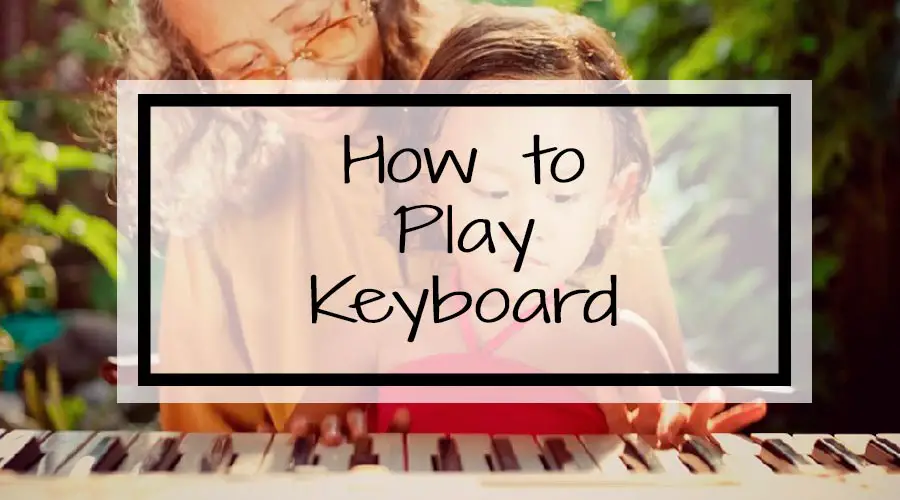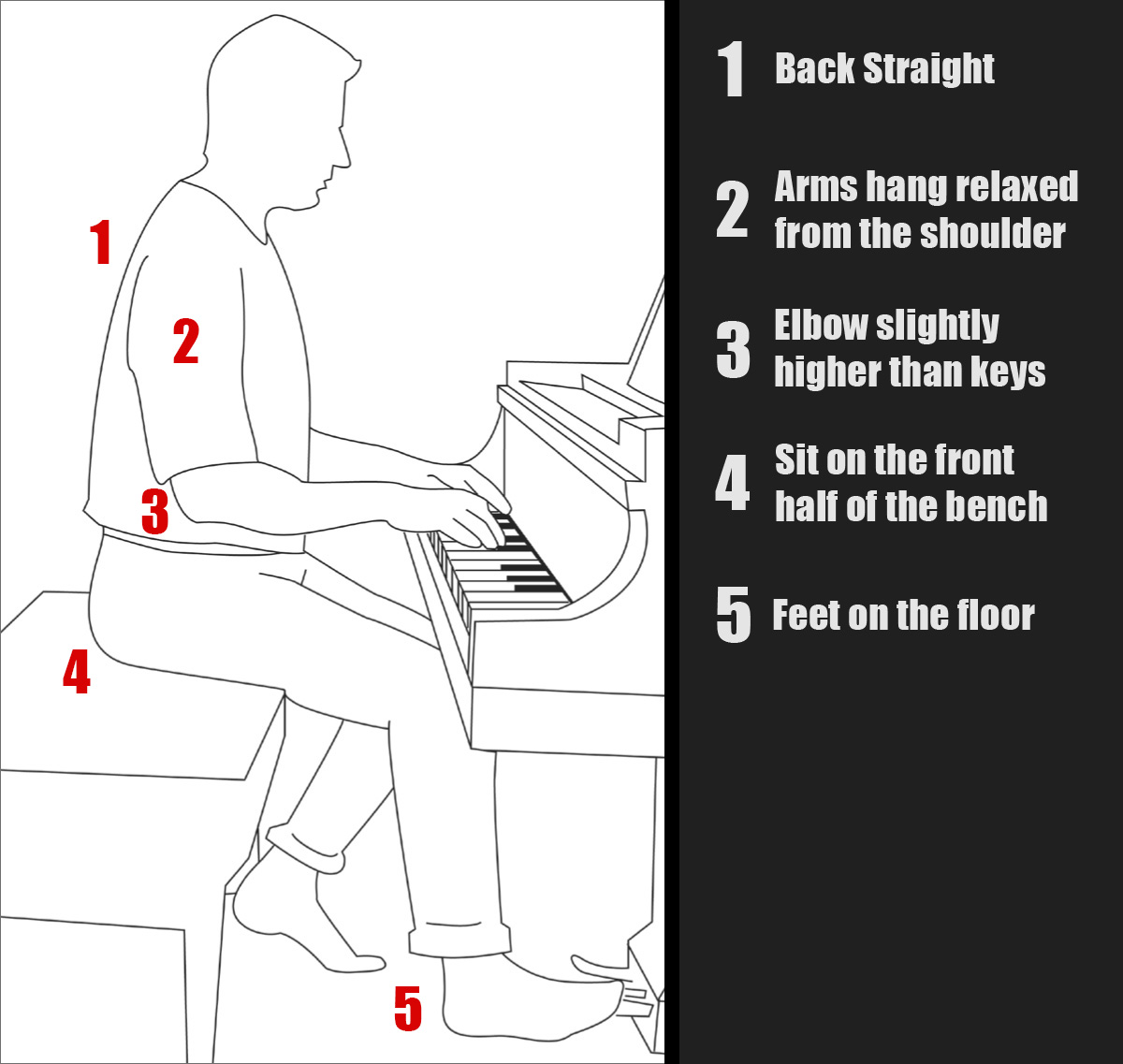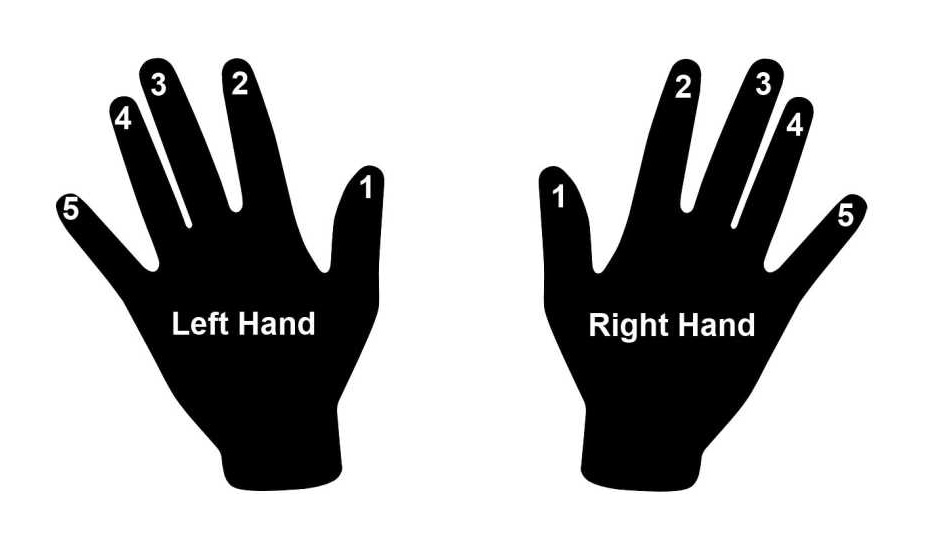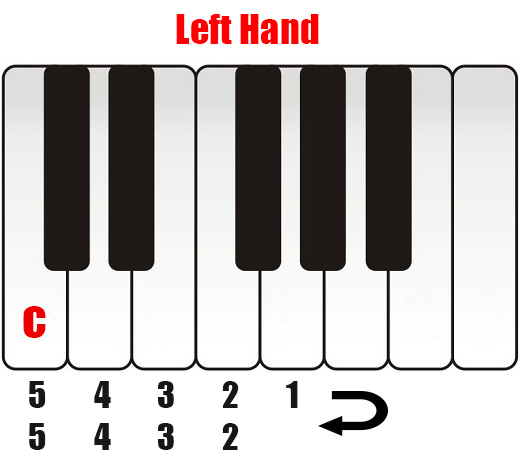
Want to learn how to play keyboard, but don’t have the time for traditional piano lessons?
Table of Contents
- How to Sit at a Piano
- 7 Beginner Piano Lessons
- Right Hand Fingering
- Left Hand Fingering
- Staccato
- Right Hand Exercise 1
- Right Hand Exercise 2
- Left Hand Exercise 1
- Left Hand Exercise 2
- Two Hand Exercise 1
- Two Hand Exercise 2
- Two Hand Exercise 3
- Two Hand Exercise 4
- Best Keyboard Piano Songs
- Fun Piano Songs
- Easy Piano Songs for Kids
- Easy Popular Songs to Play on Piano
- Beginner Classical Piano Songs
- Disney Piano Sheet Music
In this complete guide we give you piano lessons for beginners that will have you playing simple songs in no time at all!
How to Sit at a Piano
Before you can start learning how to play the piano, you should learn how to sit at one properly. Proper piano posture is important, because you need to learn how to reach the whole keyboard span comfortably.
You should be sitting up straight, but not so straight that you are stiff. You need to also feel relaxed. Keep your feet flat on the floor, with your right foot slightly ahead of the left (for the pedals).

Your bottom should be firmly planted on the bench, forward so your thighs are barely on the bench. Sit at the center of the instrument.
Lean forward just a bit, with your arms hanging loosely at your sides. Bring up your hands so they are lightly resting on the keys. Your elbows should be a little bit higher than the keys, and bent so your forearms and the floor are parallel to one another. You may need to adjust the bench to get just the right arm position. Once you are in the proper position, your knees will be just under the keyboard.
7 Beginner Piano Lessons
Two things we need to discuss before diving into the actual piano lessons are fingering and keyboard layout.
Let’s start with fingering:
- When your fingers are resting on the keyboard, they should be curved, just like if you were holding a ball.
(It’s also a good idea to keep your fingernails short.)
Now you can learn about actual fingering, or where your fingers need to be on the keyboard.
This is important, because one of the biggest mistakes many beginners make is improper fingering, which makes it difficult to learn scales, arpeggios, chords, etc. This small step is going to make learning how to play the piano a lot easier.

|
1 – Thumb |
2 – Index finger |
3 – Middle finger |
4 – Ring finger |
5 – Pinky |
|---|
The following lessons use the numbering technique. This means that the various notes will correspond to certain fingers, which are numbered.
In addition to making it easier to play the piano, fingered piano music also makes it easier to learn how to read music notation.
Along with the notation, there will be numbers either above or below the notes, which represent which fingers to use (it is the same for both hands).
Now let’s talk about keyboard layout, because you will need where your fingers are supposed to go. Whether you choose a real acoustic piano or an electronic keyboard, the layout is going to be the same, although a keyboard may have fewer keys.
Optimally, if you are using a keyboard, it should have 88 keys, just as an acoustic piano does. Some keyboards have 49, 61, or 76 keys. If you are serious about learning how to play, the minimum amount of keys your keyboard should have is 61.

No matter how many keys your keyboard has, there will always be 12 notes that are repeated all the way across the keyboard, from left to right (bottom to top). Our goal is to ensure that you will be able to find any of these notes in any part of the keyboard. The first note you need to find is Middle C. This is the white key that is to the left of the first of the two black keys that are nearest the center of the piano or keyboard.

Okay, so you know that there are 12 notes, which means that Middle C can be found every 12 notes. So, look for all of the Middle C’s on the keyboard, and play them. They should sound the same, but be higher or lower in pitch. If you play two or three C’s at once, you will see that they are in harmony.
Now that you know where the C is on any part of the keyboard, you can start figuring out where all of the other notes are, from A to G. If you play all of the white keys from one C to another, you will be playing the “Do, Re, Mi, Fa, So, La, Ti, Do” scale that you learned as a child in school. We will get into the fingering of the various notes a bit later.
We’ve only talked about the white keys. What are the black keys? This can get a bit confusing for beginners, because each of these notes has two names: sharp and flat.
Play a Middle C note. Now, play the first black key to the right. This would be C sharp. Next, play the black key to the left of Middle C. This note is C flat.

Now that you know the basics of fingering and the keyboard layout, let’s start learning how to play the piano.
This first lesson will be simple, so you can start to get the feel of the piano keyboard, and learn proper form for the wrists, hands, and fingers. We will do this through a series of simple exercises. Start by sitting properly at the piano or keyboard.
Right Hand Fingering

With your right hand on the keyboard, find the Middle C, and place your 1 finger on it (thumb). Next, place your 2 finger (index finger) on the white note to the right of Middle C. Place the 3 finger (middle) on the next white key, the 4 finger (ring or third) on the next, and finally, your 5 finger (pinky) on the next white key. All five fingers should be resting on these five keys. Keep your wrist up so your fingers can be curved. This will be position 1, or Middle C position.
Now that your right hand is in this position, it is time to play a short, numbered pattern, one note at a time, releasing each note before pressing the next. The pattern is as follows:
|
1 – 2 – 3 – 4 – 5 – 4 – 3 – 2 – 1 |
|---|
Make sure that you are only moving your fingers, and that your hand is neither moving nor rocking back and forth as you play each note. It may take a while to get used to playing the notes with fingers 3 and 4, but it will come with practice.
Now comes what may seem like a really boring part of the lesson, but it is necessary to help you learn the numbering, and to get your fingers moving. Each note must be played separately, and at the same volume (hitting each note with the same amount of force). Play each note slowly at first, with no pauses between notes.
Repeat the exercise over and over until you can do it perfectly. Once you can play it at a slow speed, you can begin to increase the speed at which you play the notes. Remember, you still have to play each note with equal force so they have the same volume. This is known as playing “legato” style.
Left Hand Fingering

For this lesson, we are pretty much going to repeat Lesson 1, but with the left hand instead of the right. The numbering will look a little different, because it is backwards. The first thing to do is to once again locate Middle C again, but with the left hand this time. Begin by placing the 5 finger on Middle C. Next, place the 4 finger on the white key beside Middle C, followed by 3, 2, and 1 fingers on the next three white keys. For this lesson, this is position number one. Your fingers should be in this position, resting on the keys.
|
5 – 4 – 3 – 2 – 1 – 2 – 3 – 4 – 5 |
|---|
Was this easier, more difficult, or the same level of difficulty as it was with your right hand? Now, try the same exercise, playing each note, one at a time, without pausing between notes, and playing each note with the same amount of force. Again, keep doing this until you can do it perfectly, and then begin to increase the speed at which you are playing the series of notes.
As with the right hand, make sure that your hand is steady, and that it is not moving or rocking. You want your fingers to do most of the work. Once again, you are playing in legato style.
Staccato

Now that you have mastered playing a few notes legato, it is time to learn how to play staccato. You will be playing the same patterns as above, but instead of playing the notes so they ring, they will be played in short bursts. Start by trying it with a single note. Strike the key quickly, over and over again. This is staccato. Once you are able to do this on one note, start using this style for the entire sequence. Play it slowly at first, then build up your speed as you feel comfortable playing the notes in this style.
Many beginners make the mistake of tensing their hands when playing staccato. It is important to keep your hands relaxed, and not tense up the muscles. The tenser your hands are, the less speed you will be able to achieve. But, at this point in your lessons, it is okay to bounce your hands up and down while doing the staccato motion, as long as they are bouncing from the wrists and not from the arms. Make sure that you practice this style with both hands.
Let’s go back to the right hand for a little while. This is generally the lead hand, the one that plays the melodies while the left hand plays the bass lines. In this lesson, we will be doing some right hand exercises in the C Major position. Remember the numbered finger system you learned earlier? This is where it will really start to come in handy.
We are going to start with this sequence of 15 numbers, each corresponding with your fingers. Your job is to play these notes without looking down at your hand. Don’t worry, it isn’t as difficult as it sounds.
As long as your fingers are where they are supposed to be in the first place (the fingering on C we discussed earlier), you shouldn’t have any problem doing this. Okay, if you need to, you can cheat the first couple of times. But, you really need to make an effort to not watch your hands all the time while you are playing. Ready for that sequence of numbers?
Right Hand Exercise 1
|
1 – 2 – 3 – 4 – 5 – 4 – 3 – 2 – 1 – 2 – 3 – 4 – 5- 4 – 3 |
|---|
So, start with your right hand in the Middle C position, and study the above sequence of numbers. Now, slowly start playing each note, one at a time, without looking at your fingers. As long as your fingers are where they are supposed to be, you shouldn’t need to look at where they are. Once you get used to playing the sequence, start working on your speed. Practice the sequence in legato and staccato.
Right Hand Exercise 2
When you have mastered playing this sequence quickly, both legato and staccato, you can move on to something a bit more complicated. These are the same numbers, and the same fingers are used, but the sequence is scattered, so your fingers have a bit more work to do.
Each key should be hit with the same intensity. Practice until you don’t have to look at the keyboard, and then work on speed. Again, practice in legato and staccato.
|
1 – 4 – 2 – 5 – 3 – 1 – 5 – 4 – 2 – 1 – 3 – 5 – 4 – 1 – 5 |
|---|
Now that you are used to doing simple exercises with your right hand, it is time to start practicing with the left hand. Again, start in the C position on the keyboard, which is seven notes to the left of Middle C.
The numbering is the same for both hands, with the thumb being number one and the pinky being number five. Place your left hand so it is in the C position, with your fingers resting on the keys. Now, you are going to play the same sequence of numbers that you used in the first exercise for the right hand.
Left Hand Exercise 1
|
1 – 2 – 3 – 4 – 5 – 4 – 3 – 2 – 1 – 2 – 3 – 4 – 5- 4 – 3 |
|---|
Again, play each note one at a time, slowly at first, and then start building your speed, still playing the notes in legato style. Once you feel confident that you can play these notes in order without looking down at your hand, start playing in staccato. Again, start out slowly, and build up your speed as you become more confident.
Once you are able to easily play these notes in order on your keyboard, it is time to step it up to the second sequence, which is a bit more difficult.
Left Hand Exercise 2
|
1 – 4 – 2 – 5 – 3 – 1 – 5 – 4 – 2 – 1 – 3 – 5 – 4 – 1 – 5 |
|---|
Keep practicing the exercises from this and the previous lesson until you feel confident enough to start playing with both hands.
Now we are going to get into the really fun stuff, exercises using both hands. First, look for Middle C on the keyboard. Place your right hand in the Middle C position, and then put your left hand in the C position, which is located just below Middle C. Make sure that your wrists are bent and that your fingers are curled somewhat.
This is where the numbering system really comes in handy, so hopefully you have memorized the numbers that correspond to each finger. Let’s jump right into the two hand exercises.
Two Hand Exercise 1
For this exercise, you will be playing the same notes on the right hand that you played in the right hand lesson, and learning new notes for the left hand. This is because it is easier to learn things on one hand, at least when you are a beginner.
There are two lines of numbers now, with the top line being for the right hand, and the bottom being for the left hand. You will notice that there are fewer numbers for the left hand. This is because you will be playing two notes on the right hand for every one left hand note.
This may seem confusing at first, but you should have no trouble picking it up after a few tries. It is going to get you more used to playing melody lines with the right hand and bass lines with your left hand.

When playing these lines together, play the ones, threes, and fives together, holding between notes on the left hand so you can play the second note with the right hand. Then, play two notes together, hold with the left, play second note with the right, etc.
It is going to take a bit of practice to get used to using both hands, but keep on trying. Once you feel confident that you can play both lines without looking down at the keyboard, you can start increasing the speed at which you play them.
Two Hand Exercise 2
Now we are going to move on to the second exercise that you played with the right hand, and add a left hand line, just as we did above. Note that the numbers are again a bit more scattered, so you have to concentrate more on what you are doing. But, as long as your fingers are starting out in the right places in the C position, you shouldn’t even have to look down at your hands at this point.

Two Hand Exercise 3
Now that you are used to playing the notes with both hands, it is time to make it a little bit more difficult. This time, you are going to be playing the same notes with each hand, and there are no double right hand notes. Take a look at the following diagram to get a better understand of what we are talking about.

This is a bit trickier than the last exercise, because you will be going in one direction with your right hand, and in the opposite direction with your left hand. So, you will start both lines with your thumb, which is 1.
This exercise is going to really test, and improve, your coordination. The next exercise gets even trickier, but it is going to get you used to playing different notes with both hands, thereby improving your coordination even more.
Two Hand Exercise 4
Again, you will be playing two notes at the same time all the way through this exercise. But, this time, we are going to take it up a notch and make the notes for each hand completely different. So, let’s start this exercise by placing your right hand in the Middle C position, and your left hand in the C position.
Study the notes in this chart for a couple of minutes, and if necessary, take a look at the keyboard to see where they are in relation to your fingers. Then, start playing the notes, with both hands. Don’t peek at your hands. By now, you should be able to play any sequence of notes without looking, as long as you were starting out at the right place.

Yes, we know that practicing scales is boring, but it is something that every piano player needs to do if they really want to be able to play well. You don’t have to learn how to read music, or use key signatures when you are learning how to play scales. We are not going to give you a lot of complicated scales to worry about. Instead, for this lesson, we are going to simply concentrate on the C scale, which is played on the white keys.
Using the numbering for your fingers, place your hands in the C position. On the left hand, play fingers one, two, and three, or the notes C, D, and E. Your right hand should be positioned so the thumb is on F and the pinky on C, right above Middle C. On the right hand, play the next note with finger one or your thumb.
Now you can finish the rest of the scale. So, it is one, two, and three on the left hand, and one, two, three, four, and five with the right hand. Play this scale over and over again until, building up speed as you become more confident with it.
If you want to learn how to play your favorite songs on the piano, you are going to need to learn how to play chords. For the purpose of these beginner piano lessons, we are going to stick with chords in the key of C for the time being, C Major, C Major Seventh, D Minor, D Minor Seventh, E Minor, E Minor Seventh, F Major, F Major Seventh, G Major, G Dominant Seventh, A Minor, A Minor Seventh, B Diminished, and B Minor Seventh Flat Five. These are all played on the white keys, and use three to four fingers.
Let’s start with the C chord. Locate middle C on your keyboard, which is going to be the first note of the C chord (this will be the case with all chords, with the named note being the first). This is a three-note chord, with the other notes being E and G. The E note is two notes to the right of the C, and the G is four notes to the right of the C.
To play this chord, place your thumb on the C, your index finger on the E, and your ring finger on the G. Play all three notes at once. You have just played your first chord on the piano. Now that you see how easy it is, let’s take a look at the notes you need to play for the rest of the chords in the key of C. We are not going to get into finger numbering. At this point, you should have a pretty good feel for where your fingers should be placed.
C Major Seventh – C, E, G, B
Watch the video below to see it in action
D Minor – D, F, A
Watch the video below to see it in action
D Minor Seventh – C, D, F, A
Watch the video below to see it in action
E Minor – E, G, B
Watch the video below to see it in action
E Minor Seventh – D, E, G, B
Watch the video below to see it in action
F Major – F, A, C
Watch the video below to see it in action
F Major Seventh – F, A, C, E
Watch the video below to see it in action
G Major – G, B, D
Watch the video below to see it in action
G Dominant Seventh – G, B, D, F
Watch the video below to see it in action
A Minor – A, C, E
Watch the video below to see it in action
A Minor Seventh – A, C, E, G
Watch the video below to see it in action
B Diminished – B, D, F
Watch the video below to see it in action
B Minor Seventh Flat Five – B, D, F, A
Watch the video below to see it in action
Best Keyboard Piano Songs
Now that you have completed your first seven beginner piano lessons, you probably want to learn more so you can start playing songs right away. It is best to start out with simple songs, and every piano teacher will have you playing things like Mary Had a Little Lamb, no matter how old you are. Be patient, because these simple songs will start you on the path to where you really want to be. Let’s take a look at some of the best piano songs for beginners.
Fun Piano Songs
Happy Birthday to You
Yankee Doodle
The Entertainer
Amazing Grace
The Imperial March (The Darth Vader Theme)
Mexican Hat Dance
For He’s a Jolly Good Fellow
Spanish Ladies
Waltzing Matilda
Easy Piano Songs for Kids
Jingle Bells
Mary Had a Little Lamb
The Alphabet Song
Hot Cross Buns
Take Me Out to the Ballgame
Itsy Bitsy Spider
Old McDonald
Row, Row, Row Your Boat
Twinkle, Twinkle Little Star
I Love You (Barney Song)
Easy Popular Songs to Play on Piano
Imagine – John Lennon
Hey Jude – The Beatles
Happy – Pharrell Williams
Clocks – Coldplay
Grenade – Bruno Mars
Ordinary People – John Legend
Smoke on the Water – Deep Purple
Lean on Me – Bill Withers
My Heart Will Go On – Celine Dion
Perfect – Ed Sheeran
Beginner Classical Piano Songs
Ode to Joy
Ode to Joy
Fur Elise
Lohengrin
Greensleeves
Waltz from Sleeping Beauty
Minuet in C
Wedding March
Spring from the Four Seasons
Brahm’s Waltz
Disney Piano Sheet Music
Let it Go
Be Our Guest
Chim Chim Cheree
Hakuna Matata
It’s a Small World
The Siamese Cat Song (We Are Siamese)
Mickey Mouse March
Arabian Nights
A Whole New World
Under the Sea
